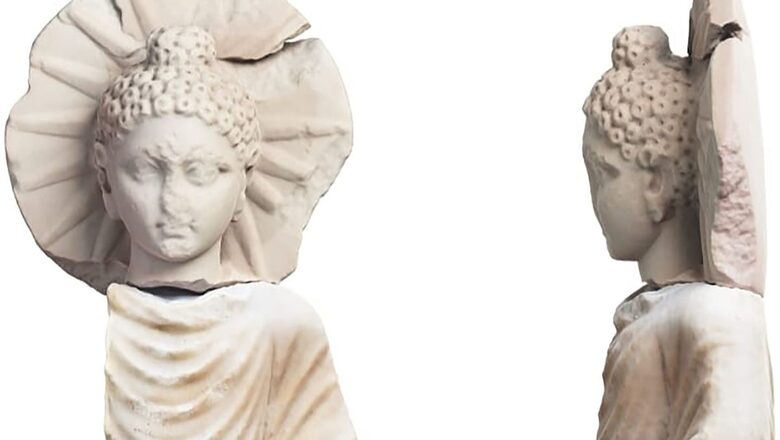
views
Ever since the discovery of a Buddha statue at Berenike in Egypt was announced in May, ancient history aficionados and academics have been speculating about how it got there. Could the Buddha – made of local marble, not imported from India or Ceylon – unearthed from a city founded by Greek-origin pharaoh Ptolemy II Philadelphus in 275 BCE, have been a gift from Buddhist Indian merchants living in the most happening African port city of that era?
Those who have seen the soldier – a dvarapala – carved on a segment of the 2,400-year-old Bharhut stupa (built around the same time as Berenike) now displayed at the Indian Museum in Kolkata, might have other ideas, though. For that ancient guardsman figure is a Yavana – a Greek – whose curly-haired head sports a royal band and who not only carries a grapevine in his hand to show his ethnicity, but his scabbard bears the distinctive Buddhist Triratna mark.
Over 1,100 km south of Bharhut, among the many remnants of Buddhist monuments pulled out of the Krishna river valley at Nagarjunakonda before the Nagarjunasagar dam reservoir submerged the area in the 1960s, is a stupa pillar with a figure of the Greek god Dionysus carved on it. He is standing in flowing Greek garb with a drinking horn in hand and a wine amphora at his feet. The great Sanchi stupa also has carvings of Greek figures – devotees? – from the time of the Indo-Greek ruler Menander (Milinda) who also became Buddhist.
The Bharhut Yavana, Nagarjunakonda’s Dionysus and other sculptural evidence of Greeks in India’s ancient Buddhist centres of worship and learning point to another possibility: that the Berenike Buddha could have been commissioned by Greeks or Graeco-Romans who had been in India as soldiers or merchants for generations – thanks to the Graeco-Bactrian and, later, the Indo-Greek states that sprung up after Alexander’s death – and had also become Buddhists.
The Greek diaspora back then was rather like today’s global Indians – leading nations around the world as Rishi Sunak and Leo Varadkar do now. Not only had central Asia and the Achaemenid Empire come into Greek control thanks to Alexander, states around the Mediterranean also had Greek rulers, including Egypt. So, being Greek opened many doors and Graeco-Roman merchants made use of that factor. Greek monks wanting to spread Buddha’s word may have done so too.
It must be remembered, though, that Indo-Greeks adopted other religious practices of that time, including Hinduism and Zoroastrianism, and probably spread word of those religions westwards, too, along trade routes. The discovery in 1938 of an ivory Lakshmi among the ruins of an ancient trading house in Pompeii – destroyed by the eruption of Mt Vesuvius in 79CE – certainly indicates that India’s ancient religions were known around the Mediterranean rim.
There is also the mysterious 2nd century BCE Heliodorus pillar at Besnagar, near Vidisha in Madhya Pradesh, installed by the ambassador of Takshashila’s Indo-Greek king Antialcidas to the court of the Indian ruler ‘Kashiputra’ Bhagabhadra. The Brahmi inscription mentions a Garuda standard and Heliodorus describes himself as a son of Dion but a devotee of Vasudeva. Greek Hindus were certainly present in ancient India. And there is a Garuda standard in Bharhut as well.
Ashoka is probably the earliest king who may have sent Indo-Greek Buddhist monks to preach dhamma to the Hellenistic world. After all, some Ashokan edicts are in Greek and have references to Greek kings, including Ptolemy II written as Turamaya, indicating Yavanas were on his radar. And Berenike, the hub of Egypt’s eastern foreign trade founded by Ptolemy II six years before Ashoka came to the throne, was an ideal place for Buddhists to set up a mission.
According to Pliny the Elder, Ptolemy II sent an ambassador named Dionysius to Pataliputra, either during Ashoka’s rule or that of his father Bindusara. And Megasthenes was an envoy to the court of Chandragupta Maurya. Moreover, there is evidence that monks from India were present in Alexandria and an unnamed ancient Indian monarch definitely sent an ambassador to the court of Augustus Caesar.
India was very much on the minds of the ancient west too. In fact, there was even an Indian angle to why Ptolemy II set up Berenike port: as a landing place for elephants. The pharaoh needed to source his own war elephants to counter the Indian ones that were the ‘brahmastra’ of his enemy, the Seleucids – a treaty between Seleucus I Nicator and Chandragupta Maurya led to the Greek getting 500 war elephants. He used them to devastating effect during the Wars of the Diadochi among Alexander’s four successors.
Earlier, the pharaoh only had Indian war elephants captured from Seleucid armies. Greek and Roman accounts reveal that Berenike was the fortified port for Ptolemy II’s fleet of elephantegoi – specially built transport ships to bring Loxodonta africana pharaohensis (a now-extinct smaller sub-species of the African bush elephant) to Egypt from the Horn of Africa. They would be unloaded at Berenike and transported overland to Alexandria.
Over two centuries later, even after the defeat of the last Greek-origin Ptolemaic pharaoh Cleopatra and Mark Antony by Roman emperor Augustus at Actium in 30 BCE, the Hellenistic merchant community at Berenike along with the ascendant Romans continued the lucrative trade with India. Ships arrived laden with pepper (8 kg has been found at Berenike), semi-precious stones and ivory, to be sent onwards to Alexandria and the rest of the Roman Empire.
Berenike remained important till the 4th century CE but declined along with the Roman Empire and was last mentioned in historical sources around 523 CE. But as excavations have found the Buddha figure inside a house of worship, black pepper, preserved Indian teakwood (from ships probably made in and sailing from Bharuch) and textiles – all within a fortified port city – the deep and multifarious Indian connections with Hellenistic Egypt deserve more attention now.
Buddhism’s fundamental link with India – as the birthplace of both the faith and its creator – is finally being asserted, and the Global Buddhist Summit held in New Delhi in April 2023 is one of many initiatives by the Narendra Modi-led government to that end. The announcement a month later of the discovery of the Berenike Buddha should lead to new research about the deep influence of faiths from India in the Graeco-Roman world, too, instead of only in regions in eastern Asia.
(The author is a freelance writer. Views expressed are personal)



















Comments
0 comment